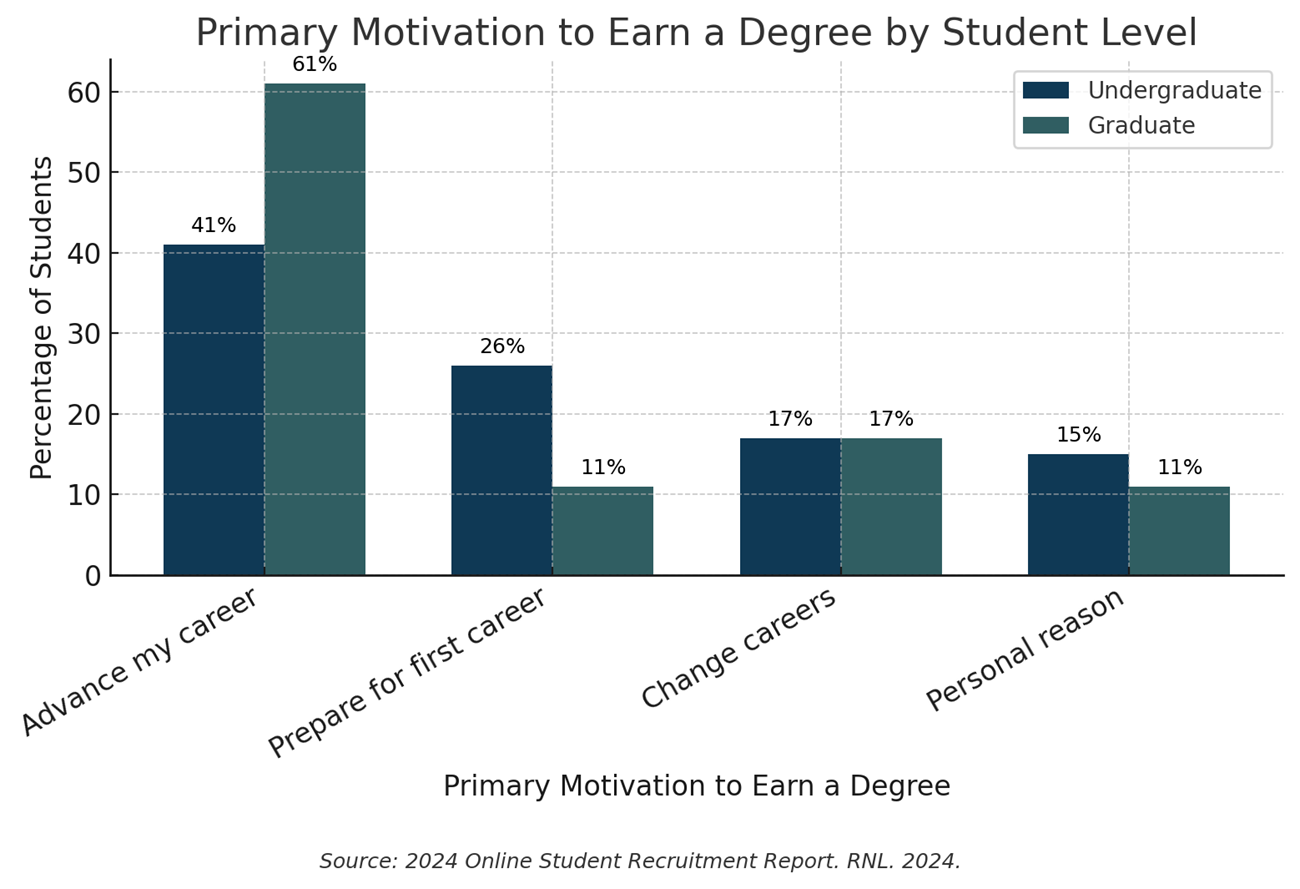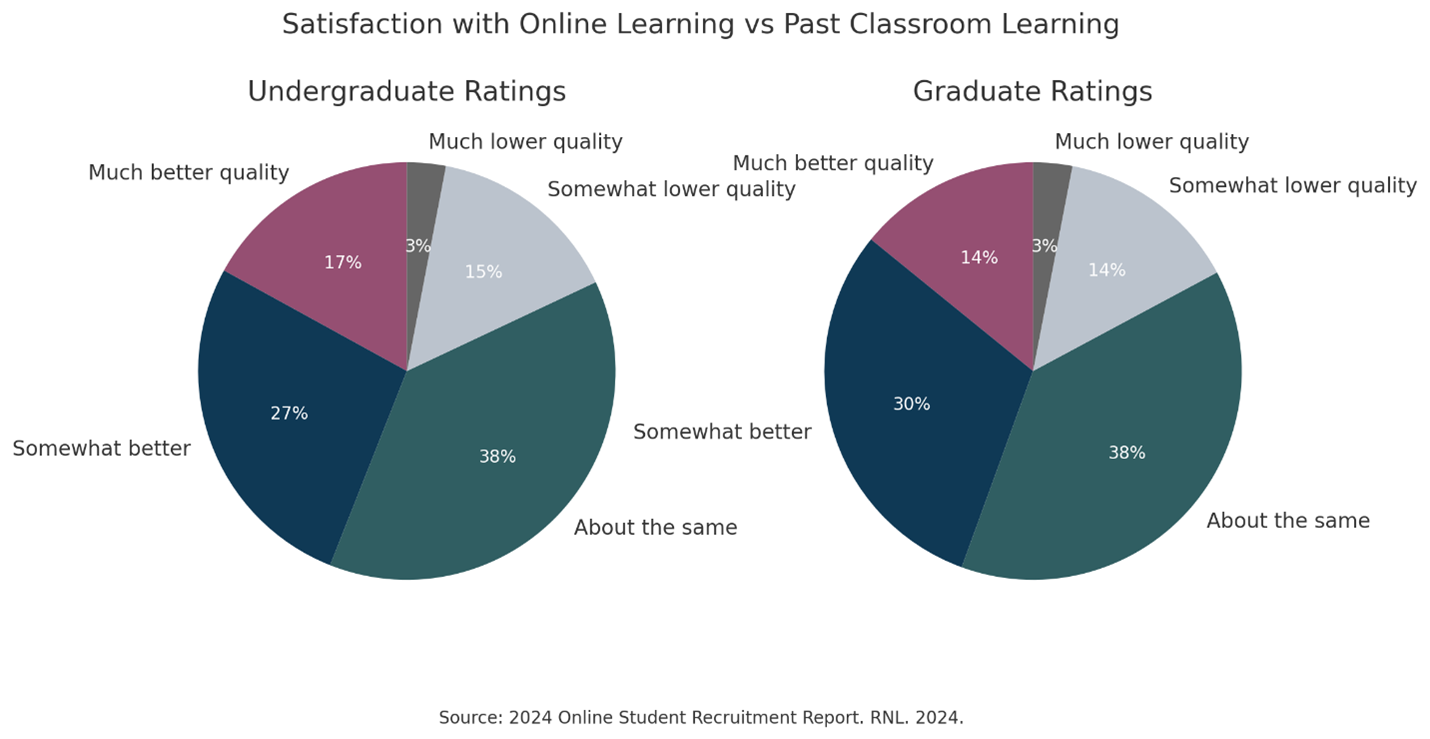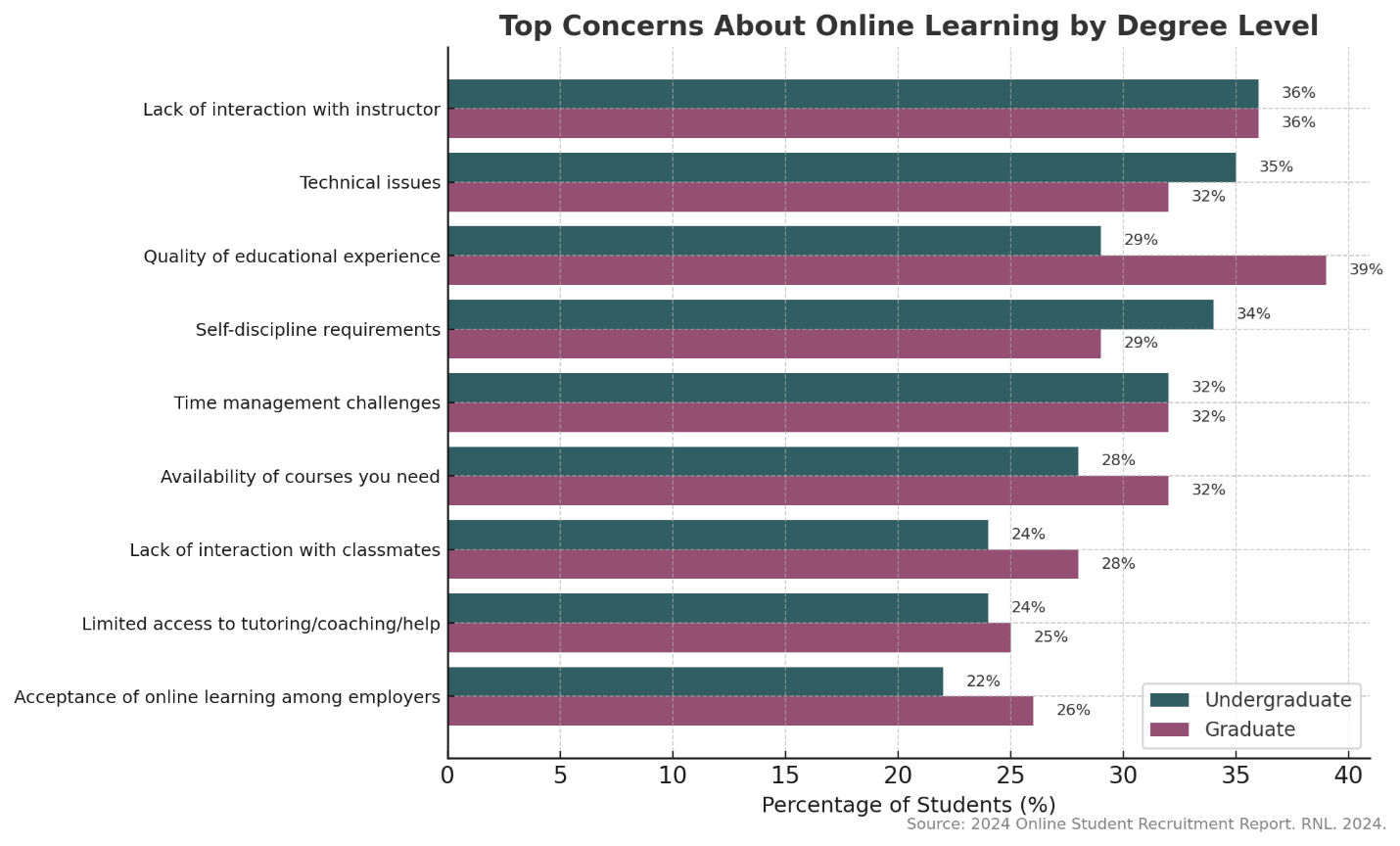
How Online Student Motivations, Satisfaction, and Concerns Need to Inform Positioning
Fun Fact: What do three of the seminal annual reports on online learning (EducationDynamics’ Modern Learner Report, Risepoint’s The Voice of the Online Student, and RNL’s Online Student Recruitment Report) have in common? Your’s truly was part of the original research team!
With this in mind, I decided to take a look at all three, and see what the EdDy and Risepoint reports could add to what I learned in RNL’s 2024 Online Student Recruitment Report about motivations, concerns, and levels of satisfaction – and how these factors affect the marketing and recruitment strategy.
Let’s explore motivations, concerns and levels of satisfaction.
Online students know what they want, they’re generally happy with what they’re getting, but they’re also clear-eyed about the gaps. If you want to win their enrollment and keep their satisfaction high, you need to speak directly to their motivations, reinforce their satisfaction drivers, and mitigate their most pressing concerns.
They are demanding because they are savvy, career-driven, and expect more than just access—they expect impactful, flexible, and dependable experiences. Understanding what motivates them, what they love, and what holds them back is no longer optional—it’s essential for crafting messaging, programming, and support that truly resonates.
Why Students Choose to Study Online
When you ask online learners what motivates them, career goals dominate almost completely — but flexibility and convenience seal the deal. From RNL’s 2024 findings:
41% of undergraduates and 61% of graduate students say career advancement is their top motivator.
Self-paced learning (29% of undergraduates, 25% of graduates) and schedule flexibility (25% of undergraduates, 28% of graduates) are the top program-selection drivers.

Student comments make it even more vivid:
“I’m looking for a promotion and a master’s degree is needed for that. Online allows me to still work while I am in school so I’m not losing any career momentum.” – Graduate student “I considered online study after Covid hit… Online learning has allowed me to make my own schedule and is affordable.” – Undergraduate student
The 2024 Modern Learner Report asks somewhat different questions, but in so doing still confirms these themes, most prominently by reporting that over two-thirds of online students citing “balancing work and family” as the main reason for choosing an online format.
High Satisfaction — and Why
I had been wanting to ask online students how they would compare the quality of their online learning experiences with past classroom experiences. We finally did just that in 2024. Here’s the part that should be music to every enrollment leader’s ears: satisfaction rates are strong. Most online students rate their experience positively, and the “why” ties directly to the flexibility, accessibility, and career alignment of their programs.

RNL data reveals that those with high satisfaction frequently cite:
The ability to work while studying.
Access to programs not available locally.
Positive interactions with faculty who understand online learners’ realities.
“It fits my schedule and allows me time to go to school around working my shifts. It also helps take care of my niece and nephew with my sister.” – Undergraduate student “I can complete my grad courses at my own pace without disrupting my work life or my family duties.” – Graduate student
Risepoint’s 2024 Voice of the Online Student shows similar results, with 85% of online students rating their online learning experience as “good” or “excellent,” largely due to “program flexibility” and “supportive faculty.”
The Concerns That Could Undermine Your Positioning
Since we were asking about satisfaction, I wanted to also be sure to ask about the things that can derail an online learning experience. We did two things: 1) asked those that rated their recent online experiences poorly why they did so, and 2) asked a specific question about what concerns ALL online students about online study.
While no single concern affects more than a third of online students, several issues still stand out:
Lack of interaction with instructors (36% undergraduates and graduates).
Technical issues (35% undergraduates, 32% graduates).
Quality of educational experience (29% undergraduates, 39% graduates).

When we analyzed the verbatim comments of online students who rated the quality of their online learning as worse than past classroom experiences, I kid you not that almost every single response related to engagement, with the themes that will surprise no one:
Poor faculty engagement.
Delayed tech support or confusing platforms.
A sense of isolation from peers.
“I have social anxiety and I don’t drive so online is a lot easier way for me to finally get a master’s degree.” – Graduate student
“I’m disabled, so online study is much easier for me than having to go from classroom to classroom with a cane and books.” – Undergraduate student
EducationDynamics’ latest findings again align with these findings with 48% of online students still indicating that they worry about “feeling connected” in a virtual environment, suggesting an ongoing opportunity for institutions to differentiate through intentional engagement design.
Ten Strategic Actions for Strong Positioning
So what does this all mean for effective positioning of your online programs in the highly competitive online marketplace? There is plenty of intelligence here – for program leaders, for enrollment teams, but perhaps most importantly for marketing staff seeking to differentiate their institution’s programs. Here are the 10 things on which I would focus like a laser beam:
1. Lead with career impact. Highlight real alumni outcomes and career advancement stories.
Messaging: “Advance your career—on your schedule.” Combine career impact and flexibility in headlines.
2. Show flexibility in action. Use video testimonials showing students juggling work, family, and study.
Messaging: Highlight stories like working parents, career changers, and students managing health or distance challenges.
3. Be transparent about faculty engagement. Outline response times, virtual office hours, and peer collaboration opportunities.
Messaging: Use stats: “85% of students say our online experience matches or exceeds face-to-face.”
Messaging: Showcase faculty interaction methods (live sessions, feedback turnaround), and peer collaboration (forums, group projects).
4. Address tech proactively. Make 24/7 support a selling point in marketing.
Messaging: Promote your 24/7 support, offer training videos, how-to guides, and rapid-response helpdesks should be easy to showcase.
5. Feature student success stories. Especially those overcoming personal or logistical barriers.
Messaging: Create videos showcasing busy students from diverse backgrounds and work situations who both managed their studies and other responsibilities.
Messaging: Create videos showcasing the career success of recent graduates – content that does “double duty” for career outcomes, and initial confidence boosting.
6. Build connection into your pitch. Create optional virtual community-building events that demonstrate that online students are a part of the community.
Messaging: Showcase and promote Virtual town halls, optional in-person ceremonies, or community events without imposing on flexibility.
7. Communicate value. Break down affordability and total ROI in plain language.
Messaging: institutions that demonstrate that their online programs are “the same” as their classroom programs reduce students thinking that it is “lesser” and should be less expensive.
Messaging: Share graduation and career placement rates, skill gains, and student satisfaction should be transparent in marketing and advisement.
8. Personalize recruitment follow-up. Use behavioral and academic interest cues from inquiries to tailor responses.
Messaging: There is no stronger messaging that you value your students than personalized and timely response – to every single incoming message.
9. Create “day in the life” content. Show real online learners managing their day.
Messaging: You can do it. If they can do it so can you.
10. Expand modular and micro-pathways. Allow stacking shorter credentials into full degrees—appeals to those balancing career-building and continued education.
Messaging: Our priority is meeting you where you are, with what you need, at the time you need it. We want to be your life long learning partner.
My Take
After reviewing all three reports, one thing is clear: institutions that own the narrative on career outcomes, flexibility, and connectedness will win in the online space. The online learner of 2024 is both pragmatic and discerning. They choose online programs for the freedom to fit education into their complex lives, but they demand a return on investment in the form of career growth, relevant learning, and strong support. Show them, don’t just tell them.
Their expectations may seem demanding, but as ALL student populations become increasingly concerned about the cost of their studies, they are coming into alignment with what online students have always demanded: career relevance, skill development, affordability, flexible formats, and customizable program content (i.e.: concentrations and elective). Mastering these issues puts institutions in a commanding position today…and tomorrow.